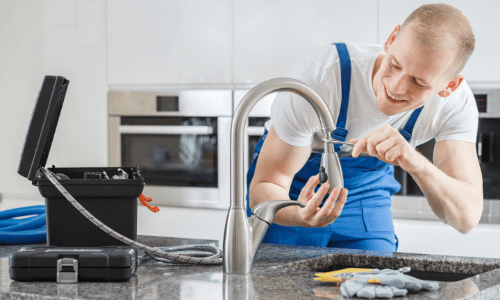Every drop of water matters, especially here in the Seattle Metropolitan area where many families are focused on both sustainability and keeping utility bills under control. One of the simplest and most effective ways to cut back on waste without sacrificing comfort is by upgrading to low-flow fixtures.

These modern plumbing fixtures are designed to use less water but still deliver strong performance. From showers that still feel luxurious to faucets that clean dishes efficiently, today’s low-flow technology has come a long way from the dribbling fixtures people worried about years ago.
What Are Low-Flow Fixtures?
Low-flow fixtures are specially designed bathroom fixtures and kitchen fixtures that limit water usage without limiting function. They include products like low-flow toilets, showerheads, and faucets, all engineered to reduce water flow while maintaining good pressure.
In most cases, these fixtures meet or exceed the standards set by the Environmental Protection Agency (EPA), which certifies products under its WaterSense program. When you see that label, you can be confident the product has been tested for both water conservation and performance.
What Are the Benefits of Low-Flow Fixtures?
When it comes to upgrading plumbing fixtures, the benefits of low-flow technology are clear.
- Lower water bills: A standard toilet can use more than three gallons per flush, while low-flow toilets cut that by more than half. Multiply that by daily use for every family member, and the savings add up quickly.
- Environmental impact: Less water used in the home means less strain on local water supplies and treatment facilities. Choosing low-flow faucets and toilets helps support broader efforts toward sustainability.
- Improved efficiency: Modern designs make sure you don’t waste water waiting for fixtures to deliver the pressure you need. Low-flow showerheads, for example, deliver a satisfying spray without unnecessary gallons going down the drain.
- Increased home value: Buyers are more eco-conscious than ever. Homes equipped with efficient bathroom fixtures and kitchen fixtures appeal to families who want built-in savings and sustainability features.
- Better long-term performance: Many low-flow fixtures are built with advanced technology and durable components, making them reliable for years of daily use. This means fewer replacements and repairs over time.
- Compliance with local standards: In many regions, building codes and renovation requirements now encourage or require water-efficient plumbing fixtures. Installing them ensures you’re ahead of the curve.
At the end of the day, these fixtures offer a balance of cost savings, environmental responsibility, and comfort that benefits the entire household.
Best Places to Install Low-Flow Fixtures
You don’t have to overhaul your whole home at once. Installing low-flow fixtures strategically can still make a big difference in water conservation.
Some of the best spots include:
- Bathrooms: Low-flow toilets and showerheads account for the biggest water savings since these are high-use areas.
- Kitchens: Low-flow faucets with aerators cut down on waste while still making it easy to wash dishes and rinse produce.
- Laundry rooms: Washing machine connections paired with efficient faucets help reduce water use for clothes care.
- Outdoor spaces: Hose bibs and irrigation systems can also benefit from low-flow technology, ensuring your garden thrives without waste.
By upgrading the most frequently used areas first, you’ll see faster savings on your water bill and a big impact on your home’s efficiency.
When to Install Low-Flow Fixtures
Timing your upgrades matters too. Some homeowners wait until they’re remodeling, while others make the switch when their current plumbing fixtures start to wear out.
Good times to install include:
- During a bathroom or kitchen renovation
- When replacing outdated toilets, faucets, or showerheads
- If you notice unusually high water bills
- When planning for long-term water conservation goals
- Before listing your home for sale to increase value
You don’t always have to wait for a major project. Swapping in a low-flow faucet aerator or showerhead can be done quickly and affordably. Sometimes the simplest updates make the biggest difference.
Common Myths About Low-Flow Fixtures
There are a few misunderstandings about low-flow technology that keep some homeowners from making the switch. Let’s clear a few of them up.
- “They don’t have enough pressure.” Modern low-flow faucets and showerheads are designed to maintain strong pressure. The technology has advanced well beyond the weak flow models of the past.
- “Low-flow toilets clog more often.” Newer designs use improved flushing technology that clears waste efficiently with less water. Many homeowners report fewer clogs, not more.
- “They’re too expensive.” While the upfront cost may be a little higher, the savings on water bills typically pay for the fixtures within a couple of years.
- “I won’t notice a difference.” That’s actually true in a positive way. Most people can’t tell they’re using less water because the fixtures are designed to feel the same as standard ones.
The bottom line is that today’s products are built to combine water conservation with everyday convenience.
How Low-Flow Fixtures Support Water Conservation Goals
Water conservation isn’t just about saving money. It’s about protecting resources for future generations. In the Seattle Metropolitan area, demand on water supplies continues to grow, and reducing household waste is a practical step we can all take.
According to the EPA, households can save thousands of gallons each year by switching to WaterSense-labeled products. That adds up not just for individual families, but for the entire community. Less strain on our treatment systems and local waterways means healthier environments and more reliable water access long term.
Upgrading to low-flow fixtures is a small change with a big impact. It’s one way each household can play a part in sustainability efforts while also enjoying personal savings and comfort.
The Installation Process: What to Expect
Many homeowners hesitate because they’re not sure what installation will involve. The good news is that replacing fixtures is often straightforward, especially when handled by professional Seattle plumbers.
Here’s what you can expect:
- An evaluation of your current fixtures to see which ones should be replaced first
- Recommendations for specific products that fit your needs and budget
- Quick removal of old fixtures and clean, professional installation of new ones
- A walkthrough of how the new fixtures work and what kind of maintenance they require
For some homes, especially older ones, upgrades might also involve adjustments to plumbing connections. That’s why working with experienced plumbers ensures the job is done right the first time.
Thinking of Upgrading to Low-Flow Fixtures? Call Gene Johnson Today!
If you’ve been considering the switch to low-flow toilets, faucets, or other water-saving plumbing fixtures, now is the perfect time. These small upgrades can make a big difference in your bills, your comfort, and your environmental impact.
At Gene Johnson Plumbing, Heating, Cooling, and Electrical, we’ve been helping homeowners in the Seattle Metropolitan area since 1976. Our family-owned team knows how to recommend the best solutions for your home, install them with care, and make sure you’re comfortable with every step. Call us today at 206.792.7495 to learn more and start saving water the smart way.





